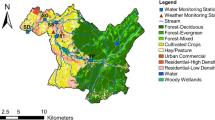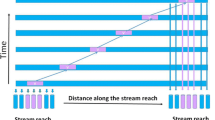Abstract
Three microbial tracers – Escherichia coli J6-2, a somatic coliphage (ØESR1) and endospores of Bacillus subtilis var. niger NCIB 8649 tracer strain JHI – were added to effluent flood irrigated onto border dyke strips at a sewage treatment plant near Christchurch, New Zealand. All three tracers, and three effluent indicators – faecal coliforms, F-RNA phages, and chloride – were recovered in a bore, approximately 100 m downstream. A simple spatial model was applied to the breakthrough curves (BTCs) in the bore, using a series of hypothetical “entry points” in the strips. This analysis indicated effluent transport velocities through the 16.8 m deep vadose zone of between 15.7 and 39.2 m hr− 1. The shapes of the BTCs for the microorganisms and chloride were very different, suggesting that they reached the groundwater table via two pathways: – both underwent rapid transport to the groundwater though macropores, but chloride also underwent far slower (matrix) transport though micropores. The BTC shapes also suggested transport velocities in the vadose zone of E. coli J6-2 > B. subtilis JH1 endospores > phage ØESR1, which is consistent with the theory of pore size exclusion, based on particle size. Reductions in microbial concentrations were ≈100 times greater than for chloride, and occurred rapidly, suggesting that up to 99% of the microorganisms underwent early exclusion from macropore flow and were removed during matrix flow. Nevertheless, the results show that substantial numbers of bacteria and viruses will still reach the groundwater through macropores beneath effluent irrigation schemes located on alluvial gravel formations.
Similar content being viewed by others
References
Abu-Ashour, J., Joy, D. M., Lee, H., Whitely, H. R. and Zelin, S.: 1994, ‘Transport of microorganisms through soil,’, Water, Air and Soil Pollut. 75, 141–158.
APHA: 1998, Standard Methods for the Examination of Water and Wastewater, 20th edn. American Public Health Association, Washington, DC.
Bitton, G., Farrah, S. R., Ruskin, R. H., Butner, J. and Chou, Y. J.: 1983, ‘Survival of pathogenic and indicator organisms in ground,’, Ground water 21, 405–410.
Debartolomeis, J. and Cabelli, V. J.: 1991, ‘Evaluation of an Escherichia coli~host strain for enumeration of F male-specific bacteriophages,’, Appl. Environ. Microbiol. 57, 1301–1305.
Gerba, C. P. and Goyal, S. M.: 1985, ‘Pathogen removal from wastewater during groundwater recharge’, in T. Asano (ed.), Artificial Recharge of Groundwater, Butterworth Publishers, pp.~283–317.
Gerba, C. P., Yates, M. V. and Yates, S. R.: 1991, ‘Quantitation of factors controlling viral and bacterial transport in the subsurface’, in C.J. Hurst (ed.), Modelling the Environmental Fate of Microorganisms, American Society for Microbiology, pp. 77–88.
Harvey, R. W.: 1991, ‘Parameters involved in modeling movement of bacteria in groundwater’, in C.J. Hurst (ed.), Modelling the Environmental Fate of Microorganisms, American Society for Microbiology, pp. 89–114.
Houston, J., Learner, M. A. and B. N. Dancer.: 1989, ‘Selection of an antibiotic-resistant strain of Bacillus subtilis~var. niger~(B. globigii) for use as a tracer in microbially rich waters,’, Water Res. 23, 387–388.
Keeley, G. M. and Quin, B. F.: 1979, ‘The effects of irrigation with meatworks-fellmongery effluent on water quality in the unsaturated zone and shallow aquifer’, Prog. Water Technol. 11, 369–386.
Martin, G. N. and Noonan, M. J.: 1977, Effects of domestic wastewater disposal by land irrigation on groundwater quality of the Central Canterbury Plains. Water and Soil Technical Publication No. 7, Wellington, New Zealand, Ministry of Works and Development.
McCabe, W. J. and Rowse, O. J.: 1976, Underground Water Flow at Burnham. New Zealand Institute of Nuclear Sciences, Report No. INS-R-189.
McFeters, G. A., Bissonnette, G. K., Jezeski, J. J., Thomson, C. A. and Stuart, D. G.: 1974, ‘Comparative survival of indicator bacteria and enteric pathogens in well water,’, Appl. Microbiol. 27, 823–829.
Noonan, M. J. and McNabb, J. F.: 1979, ‘Contamination of Canterbury groundwater by viruses’, in M.J. Noonan (ed.), Groundwater. The Quality and Movement of Groundwater in Alluvial Aquifers of New Zealand, Department of Agricultural Microbiology Technical Publication No. 2, Lincoln University, Canterbury, New Zealand, pp. 195–201.
Pang, L., Close, M. and Noonan, M.: 1998, ‘Rhodamine WT and Bacillus subtilis~transport through an alluvial gravel aquifer,’, Ground Water 36, 112–122.
Pang, L., Close, M., Goltz, M., Noonan, M. and Sinton, L.: 2005, ‘Filtration and transport of Bacillus subtilis~spores and the F-RNA phage MS2 in a coarse alluvial gravel aquifer: Implications in the estimation of setback distances,’, J. Contam. Hydrol. 77, 165–194.
Peterson, T. C. and Ward, R. C.: 1989, ‘Development of a bacterial transport model for coarse soils,’, Water Resour. Bull. 25, 349–357.
Quin, B. F. and Forsythe, L. J.: 1978, ‘Surface irrigation of pasture with treated sewage effluent. II. Drainage losses of nitrate and other nutrients,’, N. Z. J. Agric. Res. 21, 427–434.
Schijven, J. F. and Hassanizadeh, S. M.: 2000, ‘Removal of viruses by soil passage: Overview of modeling, processes, and parameters,’, Crit. Rev. Environ. Sci. Technol. 30, 49–127.
Sinton, L. W.: 1980, ‘Two antibiotic-resistant strains of Escherichia coli~for tracing the movement of sewage in groundwater,’, J. Hydrol. (NZ) 19, 119–130.
Sinton, L. W.: 1986, ‘Microbial contamination of alluvial gavel aquifers by septic tank effluent,’, Water Air Soil Pollut. 28, 407–425.
Sinton, L. W. and Ching, S. B.: 1987, ‘An evaluation of two bacteriophages as sewage tracers,’, Water Air Soil Pollut. 35, 347–356.
Sinton, L. W. and Close, M. E.: 1983, Groundwater tracing experiments. Publication No. 2 of the Hydrology Centre, Ministry of Works and Development, Christchurch, New Zealand.
Sinton, L. W., Finlay, R. K. and Reid, A. J.: 1996, ‘A simple membrane filtration-elution method for the enumeration of F-RNA, F-DNA and somatic coliphages in 100 ml water samples,’, J. Microbiol. Methods 25, 257–269.
Sinton, L. W., Finlay, R. K., Pang, L. and Scott, D. M.: 1997, ‘The transport of bacteria and bacteriophages in irrigated effluent into and through an alluvial gravel aquifer,’, Water Air Soil Pollut. 98, 17–42.
Sinton, L. W., Noonan, M. J., Finlay, R. K., Pang, L. and Close, M. E.: 2000, ‘Transport and attenuation of bacteria and bacteriophages in an alluvial gravel aquifer,’, N. Z. J. Marine Freshwater Res. 34, 175–186.
Tim, U. S. and Mostaghimi, S.: 1991, ‘Model for predicting virus movement through soils,’, Ground water 29, 251–259.
USEPA.: 1991, Test methods forEscherichia coli in drinking waters. EPA-600/4-91/016., United States Environmental Protection Agency, Washington, DC.
Vilker, V. L.: 1981, ‘Simulating virus movement in soils’, in I. K. Iskandar (ed.), Modelling Wastewater Renovation: Land Treatment, Wiley, New York, pp. 223–253.
Yates, M. V., Gerba, C. P. and Kelly, L. M.: 1985, ‘Virus persistence in groundwater,’, Appl. Environ. Microbiol. 49, 778–781.
Author information
Authors and Affiliations
Corresponding author
Rights and permissions
About this article
Cite this article
Sinton, L.W., Braithwaite, R.R., Hall, C.H. et al. Tracing the Movement of Irrigated Effluent into an Alluvial Gravel Aquifer. Water Air Soil Pollut 166, 287–301 (2005). https://doi.org/10.1007/s11270-005-6652-x
Received:
Accepted:
Issue Date:
DOI: https://doi.org/10.1007/s11270-005-6652-x




